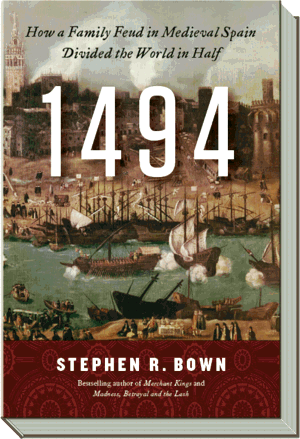1494
How a Family Feud in Medieval Spain Divided the world in Half
Description
The true story involving a corrupt pope — the patriarch of the family fictionalized in the hit Showtime series The Borgias — in an explosive feud between monarchs and the Church that divided the world in half.
When Columbus triumphantly returned from America to Spain in 1493, his discoveries inflamed an already-smouldering conflict between Spain's renowned monarchs, Ferdinand and Isabella, and Portugal's Joao II. Which nation was to control the world's oceans? To quell the argument, Pope Alexander VI — the notorious Rodrigo Borgia — issued a proclamation laying the foundation for the Treaty of Tordesillas of 1494, an edict that created an imaginary line in the Atlantic Ocean dividing the entire known (and unknown) world between Spain and Portugal. The edict was to have a profound influence on world history: it propelled Spain and Portugal to superpower status, steered many other European nations on a collision course and became the central grievance in two centuries of international espionage, piracy and warfare.
The treaty also began the fight for "the freedom of the seas," a distinctly modern notion, championed in the early seventeenth century by the Dutch legal theorist Hugo Grotius, whose arguments became the foundation of international law.
At the heart of one of the greatest international diplomatic and political agreements of the last five centuries were the strained relationships and passions of a handful of powerful individuals. They were linked by a shared history of quarrels, rivalries and hatreds that dated back decades. Yet the struggle ultimately stemmed from Isabella's determination to defy tradition and the king and to choose Ferdinand as her husband.

